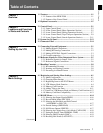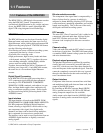
Chapter 1 Overview
Chapter 1 Overview 1-1
Chapter 1 Overview
1-1-1 Features of the HDW-F500
The HDW-F500 is a HD digital videocassette recorder
using the HDCAM
1)
format. Comparable to a
conventional digital Betacam in size, weight, and ease-
of-use, the HDW-F500 is a small, lightweight HD
digital VTR using integrated circuit technology.
HDCAM Format
The HDCAM format was developed from the digital
Betacam format, and retains the same ease of use of
digital Betacam, while yielding high performance HD
digital recording and playback. The HDCAM format
uses the following technologies:
• Pre-filtering and a new coefficient recording system,
compressing the data by a factor of seven.
• Powerful error-correcting codes
• High-performance, high-accuracy heads and drum
with dynamic tracking (DT)™, together with a new
auto-tracking technique, yielding highly reliable
narrow track recording and playback.
Together, these technologies allow 120 minutes of
recording on a (large size)
1
/2-inch HDCAM cassette,
the same size as a conventional digital Betacam
cassette.
Digital Signal Processing
In an HDCAM VTR, the signal processing takes a
4:2:2 component signal which has been quantized
according to ITU-R709/SMPTE 274M/SMPTE
260M(BTA S-002B) standards, and subjects it to pre-
filter, and then further applies data compression by
using a coefficient recording system. Audio signals
are processed using full bit processing based on the
AES/EBU format.
Input interface
The input interface is based on the SMPTE 291M/
292M/299M(BTA S-004B/-005B/-006B) /ARIB STD
B-4 HD component SDI(Serial Digital Interface)
format, allowing a single BNC coaxial cable to carry
one component video signal, four digital audio
channels, and time code in time division multiplex;
this is separated for conversion to parallel data.
The interface can be used to record audio data from an
AES/EBU digital interface or digitally converted
analog signals.
Bit rate reduction encoder
The component video signal data is compressed by a
factor of about four by a process in which it is
subjected to frame shuffling, blocking, DCT (discrete
cosine transform), quantizing adjustment, and variable
length word encoding. This is the core of the newly
developed coefficient recording system.
ECC encoder
The outer ECC (Error Correction Code) is added to the
compressed video and audio data, followed by the
inner ECC, ID data, and sync data. The Reed-
Solomon code is employed in this error correction
system.
Channel coding
Video and audio data with the ECC added is recorded
in the form of serial data. The HDCAM format adopts
a scrambled NRZI channel coding system for off-track
and noise characteristics.
Playback signal processing
The playback digital data is equalized by equalizer
circuits and error-corrected by powerful inner and
outer ECC, which can correct most data disturbed by
noise and dropouts in the reproduced signal. Data that
cannot be completely corrected in this way is passed
through a bit reduction decoder and corrected by an
error concealment circuit.
Output interface
Component video data are converted into serial data
and multiplexed with audio data and time code, then
output in the HD SDI format.
By installing an HD-SD Converter Board (HKDV-
501A; optional accessory), D1 SDI or D2 SDI and
analog composite outputs are also available.
Audio output can be data from the AES/EBU digital
interface or analog audio converted from digital
signals.
1-1 Features
..........................................................................................................................................................................................................
1) HDCAM is a trademark of Sony Corporation.


















